Murano strawberry variety
It rarely happens that in any sort of strawberry, high commercial characteristics and qualities, so appreciated by ordinary summer residents, are harmoniously and without prejudice to each other. And this is, first of all, the taste and sweetness of the berries. Many varieties have really just huge fruits, excellent productivity, disease resistance - but the tasting characteristics leave much to be desired ... Or, on the contrary, the taste is sweet and excellent, the berries simply melt in the mouth, but at the same time they are not transportable at all, and sometimes the yield limps. A completely different situation for our hero - an Italian, who reasonably claims to become great!

A brief history of creation
Murano was bred in 2004 by Italian breeders Michelangelo Leis and Alessio Martinelli as a result of crossing non-patented numbered varieties R6R1-26 and A030-12. Since 2006, the resulting plant has been tested for five years in different European countries with different cultivation methods and weather conditions. The new strawberry was patented in 2012 and belongs to the Consorzio Italiano Vivaisti. It is named after a large island near Venice (Italy) - Murano, which is famous all over the world for the production of the most beautiful art glass, in turn called Murano.
Description
This is one of the most versatile, tasty and productive varieties of strawberries on neutral daylight hours. Refers to remontant varieties with an early ripening period.

The plant is medium-sized, the bushes are compact and slightly leafy, which provides a more compact planting density, and therefore the ability to plant a larger number of seedlings in the desired area. This, in turn, will entail an increase in yield without expanding the area of the plantation. The leaves are of a rich green color, of medium size, the peduncles are located above them, which simplifies the visual detection of berries during the selection and greatly facilitates this event. Murano's flowers are large, self-pollinated. Interestingly, it takes about a month from the beginning of flowering of strawberries to the beginning of ripening of fruits, which helps in planning the harvesting schedule. Unlike some neutrals, in which fruiting goes in waves, our hero forms flowers with enviable regularity. It also makes it possible to control the number of samples and their timing by trimming emerging stems or plucking the flowers themselves. But this is quite labor-intensive and relevant only for a small area of the plantation.

The berries are red-orange in color, beautifully regular conical shape, shiny, uniform, large and heavy. They immediately attract attention with excellent product characteristics. Rarely can a variety boast a truly high tasting performance. Murano is one of those. The fruits are really rich strawberry flavor, very sweet, aromatic, have an excellent balance of sugar and acid, sourness is not felt even in unripe berries. The strawberry flesh is firm, but very juicy, without an "apple" crunch on the bite and "wood" flesh, as, for example, the famous remontant Albion, one of the first and really noteworthy varieties on our market, which is the parent of another strawberry hit - San Andreas.
The average weight of Murano berries in the season is 20-25 grams, but it can be up to 35 grams. According to patent data, the average length of the fruit is 4.3 cm, the width is 3.3 cm. The seeds are small, practically not felt. The declared yield is 0.9 - 1.1 kg per plant.
Our hero is perfect for growing both in open ground and under shelters, in tunnels and greenhouses (protected ground). It also shows itself with dignity in low light conditions and is suitable for late-autumn circulation in heated greenhouses.
The berry is very layable, dense, transportable, its commercial qualities are at its best.Thanks to this, it can be collected even in small buckets and transported in them to the point of sale, if, of course, it is not too far away. And so, it is better to place the fruits in conventional plastic berry booties with a capacity of 0.5 and 1 kg. Another plus of Murano is good frost resistance, heat resistance (the berry is not baked in the sun) and resistance to the most common diseases of strawberries, in particular spots, as well as some pests. Ticks, so unloved by us and causing significant harm, up to the death of plants, are among them.
In the end, I would like to note several important nuances.
- Excessive irrigation during hot seasons can result in poor taste. The way out is to decrease the frequency of watering. The variety is heat-resistant and will react normally and the flavor of the berries will improve.
- Murano belongs to neutrals, which give a small number of whiskers without special agronomic techniques to get around its peculiarity. On the one hand, this is great - less effort will be spent on trimming. But for those who want to get strawberry seedlings for themselves or for sale, this can be a really serious problem. What should be done? Firstly, this is plucking flowers so that the plant stops spending resources on the future harvest. Secondly, the regular application of fertilizers with a high nitrogen content. The packaging always has the NPK formula (nitrogen, phosphorus and potassium content). For example, "Planter 10.30.10", where the number 30 is a high nitrogen content, and therefore, this complex is suitable for our purposes. Thirdly, extreme heat and direct sunlight also have a bad effect on reproduction, so shading and watering is desirable not only at the root, but also by sprinkling.
- Since the variety is very productive, to maintain high yields, regular “feeding” is needed - the use of a complex of mineral fertilizers.
- Due to the fact that Murano seedlings are in great demand, and the demand significantly exceeds the supply of high-quality seedlings, there is a high probability that after purchase, instead of the long-awaited neutral, it is not at all the same. The way out is to purchase strawberry seedlings only in reliable and trusted places.
Author: Maxim Zarechny.
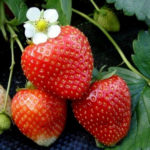
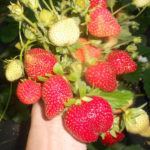
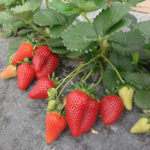
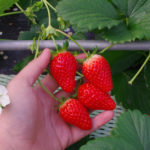
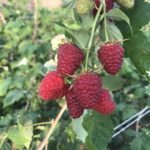
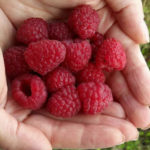



I love garden strawberries, but, unfortunately, it ends quickly - before I had to freeze the berry and eat it, since I did not like the berries of the remontant varieties at all (beautiful berries without taste and aroma). Several years ago, in the fall, I was treated to strawberries of amazing taste, and I thought that they were brought from the south, from where the treats returned yesterday. But it turned out that no - this berry was picked from the garden an hour before my arrival! Naturally, I immediately asked for a mustache of this wonderful variety - now Murano grows in my beds, and this is the only rema variety that suits me in all respects!